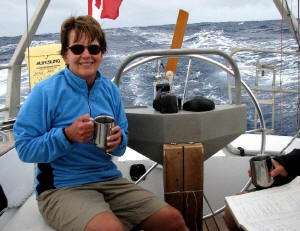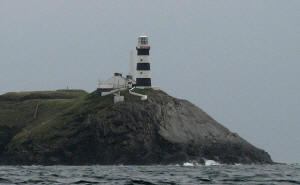It was our first light wind from astern since leaving the US, so we took the opportunity to set our new spinnaker for the first time. All went well, using the ATN spinnaker sock. The wind was only about 8 knots, but the spinnaker increased our speed from about 3 knots to 5. Once up, we smartly took the spinnaker back down, to make sure we could.
All went well with the sock, so we hoisted the spinnaker once again and carried it till the wind was up to about 20 knots, when prudence and the approaching night made us replace the spinnaker with the jib.
Just as well without the spi, because the wind built, and stayed up till we were anchored in Glandore, in Ireland 7 days later.

When we left the Azores, we also left the warm Azorean sunshine. So far, Barb is just into a fleece, first day out, but it was not long till her shorts were off too.

We had a following wind all the way, taking 7 1/2 days for the crossing. After the first "spinnaker day" the wind was too strong for it, but we kept good speed with the main (often reefed) and jib.
The seas became messy enough for us to heave to for a few hours one night, but otherwise it was just cloudy and windy.
As you can see in the photo, the Windpilot steering gear was up and out of service the whole way, because it could not handle the speed. we relied on the autopilot. It steered well, as it always has, and did not break down, (which it does too often).

Crookhaven is an ideal first-stop in Ireland, so we were disappointed to miss it.
(Double click to see full size, then use the back button on your browser to return here)
We first struck the jib, then swung to port on a beam reach, as shown in the chart. At the harbour entrance we started the engine, then swing into the wind to drop the main, expecting about 10 minutes under power to a snug anchorage. However, when Neil went forward to drop the main, he found the halyard jammed on the winch. Michael smartly turned Milvina back out to sea, while Neil wrestled with the mainsail. Since we were heading the wrong way, fast, Michael slipped the engine into gear astern to slow up. This stalled the engine, and (due to poor engineering by Volvo) this caused the shaft to jam, with the transmission jammed in gear. We got the main free, but having no engine were not about to try to beat into Crookhaven's 100 metre wide entrance in the dark, so headed off downwind, and sailed into Glandore, the closest anchorage that was easy to enter in the conditions. This was accomplished with no difficulties, and we settled down for a good snooze.

After catching up on sleep and enjoying Glandore's pubs, we headed off along the coast to Crosshaven, near Cork. We saw our first boats since leaving the Azores, and enjoyed the coastal scenery, although the weather was poor.
We passed this boat while off the famous Old head of Kinsale. He is not really in distress, just in the trough between two waves.

 Kinsale
(on the left) and Galley Head are only two of the many beautiful lighthouses
along the Irish coast.
Kinsale
(on the left) and Galley Head are only two of the many beautiful lighthouses
along the Irish coast.Once critical for navigation along this difficult coast, they are rapidly becoming unnecessary due to the advent of GPS and radar.
